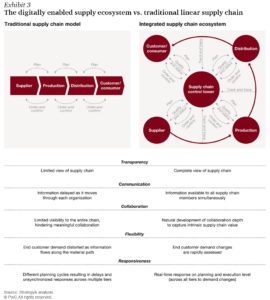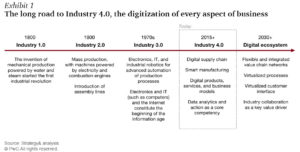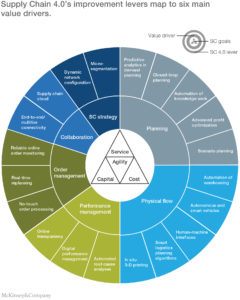Industry 4.0: Revolutionizing a Giant’s Supply Chain

During my 2-year tenure at P&G, I’ve always wondered whether digitalization can shake the retail industry in Egypt; an industry primarily controlled by wholesalers with an ultimate power of market disruption in split of seconds and an industry where price wars is a norm and tricking consumers is the way to sell…
Digitalization creates a disruption and requires companies to rethink the way they design their supply chain [1]. With this definite trend of digitalization and growing customer expectations, how can a brick and mortar CPG giant adapt to supply chain 4.0 [2]?
From the customer perspective, there are growing service expectations towards customization, full transparency and easy access to channel and SKU mix. Such changes would reflect on the supply front with stronger need of constant changes to the SKU portfolio, need to transform the supply chain to cope with a faster and more efficient system of delivery.
The new digital-driven chain poses a lot of questions [3]:

- Can P&G move from a demand/supply model to customer-centric supply chain?
- Can the system be agile enough to incorporate analytics to deliver products faster? Can it meet Amazon’s “predictive shipping”, where products become available before the customer’s reaches the purchase intent phase.
- Would it be able to respond to ad-hoc changes in demand and supply- minimizing planning cycles and frozen periods?
- Can P&G provide full visibility to customers and end-to-end transparency throughout the supply chain, ensuring that all stakeholders base their decisions on the same set of facts?
- When can P&G push its products from store-basis to digital? [4]
Digitalized Value Chain
Supply chain 4.0 comes with impacts on all areas of supply-chain management. It ultimately enables a step change in service, cost, capital, and agility, with changing a lot of improvement levers (outer circle) and value drivers (inner circle) [1].
The Game Plan
P&G has laid out a long-term plan to tackle the different levers that need to be balanced to reach a fully digitized value chain. It is operating with a mission to become the most technology-enabled business globally. In the short term, P&G is building the intimate relationship with consumers through one-on-one relationships enabled by technology. They have recently developed “consumer pulse”; utilizing Bayesian analysis to categorize consumers’ feedback allowing real-time reaction. This plays on the “collaboration” driver, pulling the level of end-to-end collaboration. This is coupled with efforts to accelerate the movements of goods from the factory to shelf. Using digitalization as a source of competitive advantage, P&G is digitizing their operations in all parts of the supply chain- from manufacturing to point of sale. On the manufacturing front, front-line employees are using iPads to pull off real time data from manufacturing lines. There’s currently strong systems, “Control Tower” and “Distributor Connect”, allowing for efficiencies on logistics and transportation. Such move resulted in a 15% cut in “deadhead” movement [3].
In the long-term, P&G envisions a system where visibility of a certain product on a certain manufacturing line in real-time is possible and accessible. Furthermore, they’re looking into integrating such system with costing control system, thus integrating accounting and manufacturing. They are also planning to be digitally connected to retailers, allowing a streamline movement of products, common data warehouse, and minimal errors between suppliers and retailers [3].
Need for a further leap?
Such plan seems well-structured and planned. However, to accomplish a fully digitized factory to shelf system, a lot of interventions need to take place. P&G needs to start from the base of the pyramid to be able to climb to the top of the digital space. Sales and Brand teams need to pivot their strategies towards maximizing value to consumers, and not for the company- only then, will real transparency occur. The age of digitization requires agility in internal and external operations. To be able to execute with agility on manufacturing and customer interface, internal processes need to be as agile and flexible to cope with ad-hoc requests and changes.
In developing countries, further efforts are needed to enable a connected digital trade. On-ground training for sales representatives and retailers is needed. Without such training, getting data from the trade will be almost impossible.
Future Outlook
A deep-dive into the future of the digitalization of retail supply chain leaves a series of unanswered questions. What is the intention of building a personalized channel with each consumer? To provide real-time data that drives further product innovation or to alter the marketing strategy to tackle the customers concerns? There is no doubt that digitalizing the manufacturing processes would allow production efficiencies, higher utilization and faster delivery, but what about digitalizing the shelf space and planogram? Is it maximizing value for consumers or pushing products that maximize value for the company?
In a developing country like Egypt with fragmented retail space and a universe of millions of touchpoints, how feasible is it to be digitally connected with retailers? With sales representatives incentivized to stock-up retailers, how doable is it to streamline movement of stocks?
(Words: 774)
References
[1] Knut Alicke, Daniel Rexhausen, and Andreas Seyfert, “Supply Chain 4.0 in consumer goods,” McKinsey&Company, April 2017, Link, Accessed November 2017.
[2] Stefan Schrauf, Philipp Berttram, “Industry 4.0: How digitization makes the supply chain more efficient, agile, and customer-focused,” Strategy&, September 2016, Link, Accessed November 2017.
[3] “Inside P&G’s digital revolution,” McKinsey&Company, November 2011, Link, Accessed November 2017.
[4] “The future of retail supply chain”, McKinsey&Company, November 2011, Link, Accessed November 2017.





Doha, great analysis, and very interesting topic! I learned a lot and find the trends you described extremely fascinating.
There is one issue that I was struggling with while reading – we all agree that the digital revolution will reshape the process in a more efficient way and will redesign many of the internal procedures. However, I guess we can also assume that these significant changes will make some of the existing “links” in the chain irrelevant and even unnecessary. I can imagine for example that if P&G will be able to follow the end-costumers trends directly, they will be able to save some the resources (and roles) that are dedicated to collecting this kind of information. We can also think of some planning and strategy function that P&G will be able to save if the process data will be recorded and sent online.
In sum, P&G might not only face a need for significant modification in their supply chain structure but also a need to reinvent their position in this new emerging eco-system.
I don’t think building personalized channels with each consumer that provide real-time data will be that helpful in the short-run for supply chain purposes. Unless these channels can achieve massive scale, I don’t think the information captured by them will be meaningful enough to act on. More importantly, digitalizing the manufacturing process requires cooperation from the full supply chain, which is more difficult in a highly fragmented retail space like Egypt. For example, even if you know that a particular group of customers will demand more of a certain product the next month, how would you figure out which retailer they would go to purchase the item? Without direct POS data from retailers (and it would be a lot of work to set up collaborations with so many fragmented players), the data collected by the manufacturer becomes a lot less valuable. Of course, one potential solution is to vertically integrate and own the entire supply chain like Amazon, which allows the Company to make full use of the direct connection to its consumers: http://www.businessinsider.com/amazon-prime-day-dash-button-deal-2017-7. The Dash Button allows Primer members to reorder household items instantly with a literal push of a button.